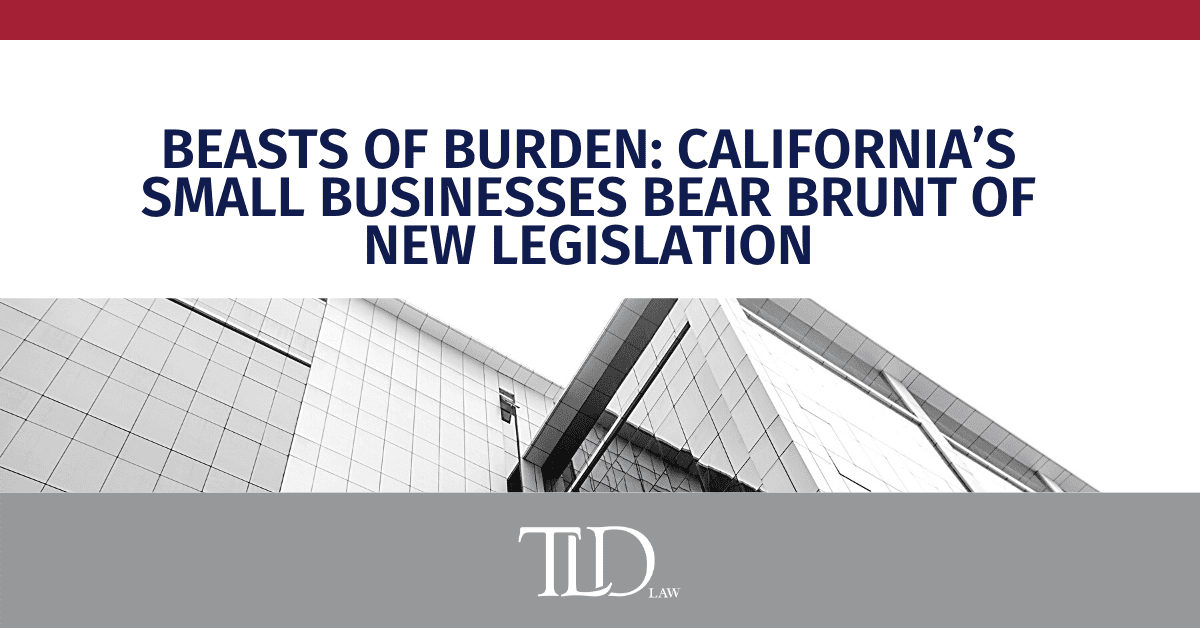
By: Shannon Jenkins, Esq.
Governor Newsom—in an economic environment already strained to the breaking point—signed health and welfare legislation that will greatly expand the California Family Rights Act (“CFRA”) to previously unaffected businesses. Originally, CFRA required covered business with 50 or more employees to provide up to 12 weeks of unpaid family and medical leave during a specified 12-month period an employee or family member’s serious health condition. You may recall that, in a sign of legislative creep, California’s New Parent Leave Act expanded the baby bonding component of CFRA to employers of 20 or more employees.
Senate Bill 1383 now expands CFRA to apply to employers with 5 or more employees, and expands the scope of “family members†for whom employees can take leave to include many additional categories. The effective date is January 1, 2021.
Genesis of the Law
According to the “Comments” section of the July 29, 2020 bill analysis from the Assembly Committee on Labor and Employment:
“In 2019, Governor Newsom signed SB 83 which extended PFL benefits from six to eight weeks, effective July 1, 2020. Governor Newsom also convened a Paid Family Leave Task Force, consisting of members of the business, legal, policy, science, and early learning communities, intended to provide policy recommendations to expand California’s Paid Family Leave Program. This bill is the result of a recommendation of this task force”.
Although the Governor’s interest in expanded family and medical leave begun in 2019, the pandemic created an urgency for proponents:
“Newly enacted federal leave tied to COVID-19 leaves out up to 80% of the workforce and expires at the end of the year, making this bill necessary to ensure California workers affected by the coronavirus can take time to care for themselves or a sick family member and keep their workplaces and communities healthy and safe”.
The argument in opposition to the legislation was powerful and provides some insight into the challenges faced by employers:
“A coalition of employer organizations, including the California Chamber of Commerce, argue, among other things, that it disproportionately impacts small employers in California with only 5 employees, exposes small employers to costly litigation even for unintentional mistakes, imposes a significant administrative burden, and adds costs to small employers even though it is not paid.
Regarding the impact on small employers with 5 employees, the Chamber asserts “[a]ccording to the most recent labor market data from the Employment Development Department (EDD), out of California’s approximately 1.6 million employers, approximately 173,000 employers in California have between 5-10 employees, and will be limited in their ability to manage this leave.†Quoting a 2011 report on Paid Family Leave, the Chamber emphasizes “[v]ery small businesses like this one [which had three employees] do face special challenges [to cover leaves] since an inevitable effect of their size is that very few co-workers are available to cover the work when someone is absent.â€
With regard to the increased exposure to costly litigation, the Chamber argues “[a]n employer with only five employees does not have a dedicated human resources team or in-house counsel to advise them on how to properly administer this leave, document it, track it, obtain medical verifications, etc. The regulations on implementing the 12 weeks of leave under CFRA are approximately 36 pages long. A small employer is bound to make an unintentional mistake along the way, which will cost them in litigation.â€
The Chamber further argues that this bill “adds costs to small employers even though it is not paid. . . . The leave is ‘protected,’ meaning an employer must return the employee to the same position the employee had before going out on leave. This means holding a position open for three months or more. While an employer can temporary fill the position with a new employee, that replacement usually comes at a premium. A replacement employee knows it is short term and, therefore, requires a premium wage, is less dedicated to the position, and often leaves for a better opportunity at a moment’s notice. Also, many jobs require extensive amount of time and money to train a new employee, adding another cost. Some employers shift the work to other existing employees, which often leads to overtime pay. And, most of the leaves of absence require employers to maintain health benefits while the employee is out.â€
Nevertheless, the Governor signed the bill into law on September 17, 2020.
Scope of the Legislation
California’s current iteration of CFRA (modeled largely after the Federal Family and Medical Leave Act [“FMLAâ€]) applies to private employers with 50 or more employees within 75 miles of the worksite (and public employers of any size). SB 1383 expands CFRA to now apply to private employers with 5 or more employees and eliminates the requirement that employees work within 75 miles of the worksite. It requires employers to provide medical and family leave to eligible employees for up to 12 weeks. Eligible employees are those with more than 12 months of service with the employer and who has at least 1,250 hours of service with the employer during the previous 12-month period. This is job-protected leave; it provides “[f]amily care and medical leave requested pursuant to this subdivision shall not be deemed to have been granted unless the employer provides the employee, upon granting the leave request, a guarantee of employment in the same or a comparable position upon the termination of the leave”.
Benefits must continue through the duration of the leave. SB 1383 also makes two other important changes to the CFRA. First, it deletes the provision of law that specifies that if both parents work by the same employers, the employer is not required to provide more than a total of 12 weeks for leave in connection with the birth, adoption or foster care placement of a child. Therefore, such an employer may now be required to provide 12 weeks to both employees in that situation. In addition, SB 1383 deletes language from the CFRA that authorizes an employer to refuse reinstatement to salaried employees who are among the highest paid 10% of the employees and where the refusal is necessary to prevent substantial and grievous economic injury.
CFRA currently allows employees to take unpaid leave for a number of purposes, including to care for a “family member†with a serious health condition. It defines “family member†to include a minor child (unless the child is both an adult and a dependent child), a spouse or a parent. SB 1383 significantly changes the definition of a “family member.†The list of family members for whom leave can be taken is expanded to include siblings, grandparents, grandchildren and domestic partners. This is materially different than the scope of the Federal FMLA. Second, the definition of “child†is expanded to cover all adult children (regardless of whether they are dependent) and the children of a domestic partner.
Employers with 50 or more Employees Face a “Stacking†Problem
There is at least one unintended consequence of the new law for employers that have 50 or more employees and are therefore covered under both CFRA and FMLA. Generally, leave under CFRA and FMLA runs concurrently, meaning an employee is generally only eligible for a total of 12 weeks of unpaid leave under both laws. However, because SB 1383 now expands the definition of “family member†under the CFRA in a manner inconsistent with the definition under the Federal FMLA, the two laws are no longer in sync. This creates the unfortunate situation in which an employee is eligible for 12 weeks of leave under the CFRA (for example, to care for a sibling, which is not covered under FMLA) but remains eligible for a full additional 12 weeks under the FMLA (if they need to later care for a child).
Mediation Pilot Program
On September 9, 2020 a budget trailer bill was signed by the Governor to create a “Small Employer Family Leave Mediation” pilot program. It applies only to employers with between 5 and 19 employees and provides that such employers may, within 30 days of receipt of a DFEH right-to-sue letter, request mediation through DFEH. The employee is not permitted to pursue a civil claim in court until the mediation is complete and it tolls (suspends) the statute of limitations on the employee’s claim during that time. This pilot program remains in effect only until January 1, 2024.
Conclusion
As with many employment laws, these new requirements are a technical compliance minefield. It will require an Employee Handbook change for all employers, new postings, a plan for handling leave requests and reorganizing staff and tracking leave. In the coming months, check the California Department of Fair Employment and Housing (www.dfeh.ca.gov) for updated pamphlets, forms and guidance.







